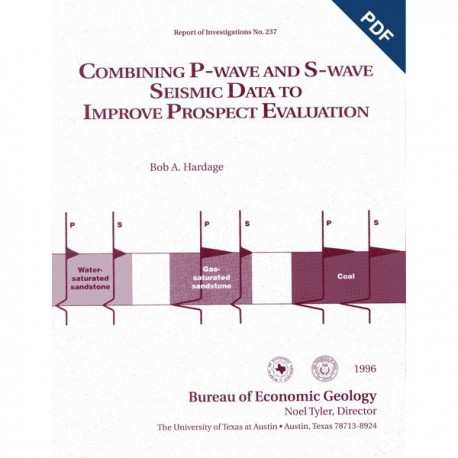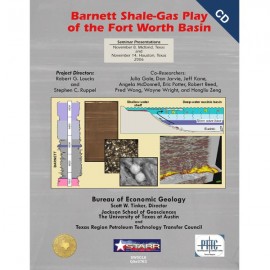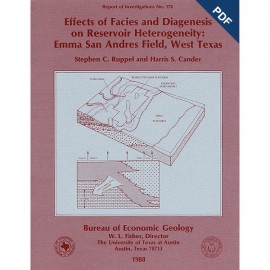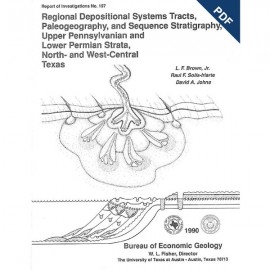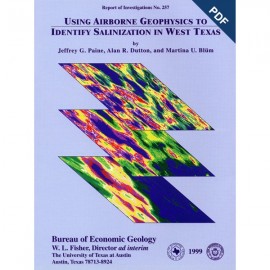Reports of Investigations
-
Books & Reports
- Reports of Investigations
- Guidebooks
- Udden Series
- Geological Circulars
- Down To Earth
- Atlases of Major Oil and Gas Reservoirs
- Texas Memorial Museum Publications
- Environmental Geologic Atlas of the Texas Coastal Zone
- Mineral Resource Circulars
- Other Reports
- Seminars and Workshops
- Handbooks
- Submerged Lands of Texas
- Symposia
- Annual Reports
- Open File Reports
-
Maps & Cross Sections
- Thematic Maps
- Miscellaneous Maps, Charts & Sections
- Geologic Atlas of Texas
- STATEMAP Project Maps
- Geologic Quadrangle Maps
- Cross Sections
- Highway Geology Map
- Energy and Mineral Resource Maps
- Shoreline Change and Other Posters
- Wilcox Group, East Texas, Geological / Hydrological Folios
- Bouguer Gravity Atlas of Texas
- River Basin Regional Studies
- Featured Maps
- Posters
- Teachers & the Public
-
Geological Society Publications
- Gulf Coast Association of Geological Societies
- Alabama Geological Society
- Austin Geological Society
- Corpus Christi Geological Society
- Houston Geological Society
- Lafayette Geological Society
- Mississippi Geological Society
- New Orleans Geological Society
- South Texas Geological Society
- GCS SEPM Publications
- Historic BEG & UT Series
RI0237D. Combining P-Wave and S-Wave Seismic Data to Improve Prospect Evaluation, by B. A. Hardage. 47 p., 37 figs., 2 tables, 1996. doi.org/10.23867/RI0237D. Downloadable PDF.
To purchase this publication in book format, please order RI0237.
About This Publication
This report presents three types of evidence documenting that the combination of P-wave and S-wave seismic data provides geologic insights that cannot be provided by conventional P-wave data alone. The study consists of three parts: (1) the basic physics and research findings related to P and S seismic wavefield behavior, (2) the application of the research findings to field-recorded 2-D P and S data to site successful wells, and (3) recommended hydrocarbon plays in Texas where P and P seismic data should be acquired, to better evaluate reservoir systems and to reveal new hydrocarbon accumulations.
ABSTRACT
Significant advantages accrue when oil and gas prospects and potential infield drill sites are evaluated with both compressional wave (P-wave) and shear wave (S-wave) seismic data rather than with P-wave data only. This report presents three types of evidence documenting that the combination of P-wave and S-wave seismic data provides geologic insights that cannot be provided by conventional P-wave data alone:
1. Field tests and laboratory measurements made on rock samples that show that distinct rock facies can be identified more reliably by combining P-wave velocity (Vp) data with S-wave velocity (V,) data than they can be by using P-wave velocity information only.
2. Examples of two-dimensional (2-D) seismic data that illustrate that combining spatially coincident P-wave and S-wave reflection images helps identify rock types, fluid boundaries, and sequence relationships that cannot be easily inferred from P-wave seismic images only.
3. Examples of seismic detection and mapping of fractured reservoirs by using the dual S-wave images that result from S-wave splitting, a phenomenon that occurs when an S-wave interacts with fractured rock. This wave-splitting phenomenon is unique to S-waves; it does not occur in P-waves.
This report consists of three parts: part 1 describes the basic physics and research findings related to P and S seismic wavefield behavior; part 2 illustrates how these research findings have been applied to field-recorded 2-D P and S data to site successful wells; and part 3 describes hydrocarbon plays in Texas where P and S seismic data should be acquired to better evaluate reservoir systems and to reveal new hydrocarbon
An important point to emphasize is that the P and S data included in this report are only 2-D seismic profiles. The value of combined P and S seismic imaging for prospect evaluation will increase many fold, compared with the value of the 2-D profiles shown in this report, if the P and S data are recorded, displayed, and interpreted as a 3-D geometry instead of as 2-D data. There is no unsolvable technical barrier that prevents three-component (3-C) seismic data from being acquired, processed, and interpreted in a three-dimensional (3-D) geometry. However, in the present economic climate, seismic contractors hesitate to make the financial investments required to offer three-component and three-dimensional (3C3D) technology services to the industry. This report provides information to the end users of seismic technology--those persons who evaluate and manage oil and gas prospects, particularly those prospects on properties in the State of Texas--so that this user community can then approach seismic contractors and assure them that there will be a market for 3C3D seismic services. This market assurance will be required before 3C3D seismic technology becomes a common commercial service.
In addition to creating user demand for 3C3D technology, this report describes those geological conditions in which the combined use of P and S seismic data will provide operators the greatest benefit, and it illustrates where some of these types of reservoir conditions exist in Texas. The Texas-based plays and trends offered as examples of where 3C3D technology should be applied (figs. 36 and 37) were selected on the basis of the following premises:
1. If a correct understanding of subsurface structure is the key to successful drilling in the play or trend, then S-wave data are not needed because 3-D P-wave data alone can define structure.
2. If successful drilling depends on locating fractures, detecting porosity trends, mapping lateral facies variations, or defining subtle stratigraphic traps, then combining S-wave seismic data with P-wave data will be invaluable and is strongly encouraged.
Keywords: bright spots, fracture detection, P-wave, S-wave, three-component seismic, 3-D seismic, Vp/Vs velocity ratio
CONTENTS
Abstract
Part 1-Basic Physics and Research Findings Related to P and S Wavefield Behavior
Laboratory Measurements of Vp and Vs
Rock Properties That Affect Vp/Vs
Extension of Laboratory Measurements of P and S Behavior to Lower Frequencies
Extension to Sonic Logging Frequencies
Extension to Seismic Exploration Frequencies
Techniques Used to Measure Vp/Vs from Seismic Data
Petrophysical Properties That Affect P and S Wavefields
Part 2-Applications of P and S Seismic Data in Prospect Evaluation
Technique 1-Comparing Spatially Coincident P and S Seismic Images
Distinguishing Lignite Beds from Gas Sandstones
Defining Gas-Water Boundaries
Summary of P and S Reflection Behavior at Water Sand Gas Sand and Lignite Bed Boundaries
Increased Insight into Sequence Relationships
Potential of Improved Spatial Resolution
Technique 2-Applying Vp/VS Ratio Behavior to Geological Problems
Using Vp/Vs Ratio Data to Distinguish Dolomite from Limestone
Using VJVs Ratio Data to Distinguish Sandstone from Shale
Using VJVS Ratio Data to Identify Porosity Trends
Technique 3-Using S-wave Splitting to Detect Fractures
Physics of S-wave Splitting
Application of S-wave Splitting to Siting of Horizontal Wells in Carbonates
Seismic Detection of Productive Fractures Oriented Contrary to Dominant Regional
Fractures in Sandstones Depth Calibration of P and S Seismic Images
Calibration Technique I-P and S VSP Data
Calibration Technique 2-P and S Synthetic Seismograms
Part 3-3C3D Prospects, Plays, and Applications in Texas
Basic Concepts of 3C3D Seismic Acquisition and Imaging
Exploration Play Concepts in Which 3C3D Technology Can Have Significant Impact
Bright Spot Plays
Stratigraphic Traps Subtle Porosity Trends
Fractured Rock Facies Exploitation Applications of 3C3D Technology
Location of Fluid Boundaries 4-D Seismic Reservoir Monitoring
Texas-Based Gas Plays That Can Benefit from 3C3D Seismic Technology
Fractured Reservoirs
Bright Spot Reservoirs
Carbonate Stratigraphic Traps
Siliciclastic Stratigraphic Traps
Texas-Based Oil Plays That Can Benefit from 3C3D Seismic Technology
West Texas Carbonate Plays
Additional Carbonate Plays
Siliciclastic Plays
Plays and Trends in Which Structure Controls Drilling Success
Conclusions
Acknowledgments
References
Figures
1. Laboratory data showing how rock types can be differentiated if velocities Vp and Vs are known
2. Behavior of Vp/Vs ratio with porosity for various well-consolidated water-saturated and gas-saturated sedimentary rocks
3. Sonic log evidence that a gas-saturated dolomite has a lower VD/Vs ratio than water-saturated dolomite
4. Vp and Vs values and Vp/Vs ratios determined from three-component VSP data recorded in a Tertiary section of the Texas Gulf Coast 5. Determining Vp/Vs ratios using zero-offset VSP data
6. Determining Vp/Vs ratios using migrated seismic reflection data
7. Relationships between petrophysical conditions that can occur at an impedance boundary and the existence of P and S reflections at that boundary
8. Use of P and S reflection data to distinguish gas sandstone reservoirs from lignite beds
9. P and S reflection images recorded along the same surface track across a gas reservoir
10. Comparison of P and S images of gas accumulations in a sandstone-shale section
11. Model illustrating P and S reflection behavior in gas sandllignite prospects
12. Spatially coincident P-wave and S-wave seismic sequences
13. Spatially coincident P-wave and S-wave sequences
14. High-resolution crosswell P-wave image of a carbonate reservoir system and crosswell S-wave image of the same interwell space
15. P-wave reflection profile across Scipio field and S-wave reflection profile along the same surface track as the P-wave seismic line
16. The ATs/ATp ratio behavior across Scipio field
17. P-wave and S-wave reflection data recorded along line 1, Empire-Abo field
18. P-wave and S-wave reflection data recorded along line 2, Empire-Abo field
19. Vp/V, ratio behavior calculated over the siliciclastic Morrow interval along line 1 and line 2
20. Sandstone isopach map derived from well control along line 1 and line 2
21. Vs/Vp ratio behavior over a prospective limestone interval as determined from three-component VSP data
22. P-wave and S-wave reflection profiles traversing the same surface track across prospect where VSP calibration data were acquired
23. P-wave profile with V, /Vp ratio values calculated for each trace coordinate
24. Expansion of V, /Vp analysis to all four lines of P and S seismic grid
25. Principles of S-wave splitting in a fractured rock medium
26. Relationship between polarization orientations of Sl and S2 wave components and subsurface stress field and rock strength behavior of propagating medium
27. S and S2 images traversing the same surface track across Austin Chalk
28. S2 reflection profile across a small lease block over Austin Chalk and fractures found along the horizontal leg of a well drilled in the plane of the 2-D seismic image
29. Fracture orientation and seismic grid used for fracture analysis
30. Comparison of P-wave images along each surface track
31. Comparison of SH images along each surface track
32. Comparison of event-aligned SH images
33. VSP technique for calibrating stratigraphic depth to P-wave and S-wave seismic image time
34. Processed three-component VSP data used to calibrate stratigraphic depth to P and S seismic image times
35. Full-waveform sonic log data
36. Gas plays and trends that will potentially benefit from availability and use of 3C3D seismic technology
37. Oil plays and trends that will potentially benefit from availability and use of 3C3D seismic technology
Tables
1. Ranges of Vp/Vs in typical rocks
2. Relationships among elastic constants of an isotropic medium
Citation
Hardage, B. A., 1996, Combining P-Wave and S-Wave Seismic Data to Improve Prospect Evaluation: The University of Texas at Austin, Bureau of Economic Geology, Report of Investigations No. 237, 47 p. doi.org/10.23867/RI0276D.
